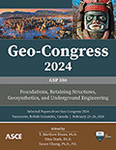Some Rehabilitation Schemes for Geosynthetic-Reinforced Soil Abutments on Soft Soil Foundations
Publication: Geo-Congress 2024
ABSTRACT
Soft soil, due to its high compressibility and low strength, poses several threats to the overlying structures. The design of infrastructure founded inevitably on such incompetent foundation soils demands due diligence to accommodate for unintended adverse effects raised by excessive subsidence in such soils. Geosynthetic-reinforced soil (GRS) abutments are among the important structures constructed for different important purposes. Slope stabilization and bridge abutments are two examples of such applications. These composite structures contain different load-carrying elements, which come into play when superimposed by dead and live loads. Geosynthetics reinforcing elements, facing panels, backfill quality, underlying foundation competence, and the toe reaction condition are among the most important factors impacting the overall behavior of such structures. The existing literature in geotechnical engineering mainly focuses on the normal practice of using such walls where the foundation soil is assumed competent enough before embarking on the construction of the overlying GRS abutment. However, there are situations in civil engineering that are imposed by the harsh local and environmental conditions, and proper maintenance of the erected structure is necessary to minimize potential issues. Soft soils, found abundantly in Canada, provoke the GRS abutment system detrimentally by mobilizing extra load values at the reinforcement-facing connection points and along the length of different layers. This article explores the resilience of the GRS abutment system in handling the adverse effects of underlying soft soil. It delves into the assessment of different retrofitting measures and demonstrates their respective effectiveness.
Get full access to this article
View all available purchase options and get full access to this chapter.
REFERENCES
AASHTO. (2020). AASHTO LRFD Bridge Design Specifications. American Association of State Highway and Transportation Officials, Seventh Edition, Washington, D.C., USA.
Adams, M., and Nicks, J. (2018). Design and construction guidelines for geosynthetic reinforced soil abutments and integrated bridge systems., Federal Highway Administration, Washington, D.C., USA.
Bathurst, R., Puig Damians, I., Ezzein, F., Josa Garcia-Tornel, A., and Lloret Morancho, A. (2012). Influence of foundation compressibility on reinforcement loads in geosynthetic reinforced soil walls. In Proceedings of the 5th European Geosynthetics Congress: vol. 5: Soil Improvement and Reinforcement (pp. 43–47). International Geosynthetics Society (IGS).
Damians, I. P., Bathurst, R. J., Josa, A., and Lloret, A. (2014). Numerical study of the influence of foundation compressibility and reinforcement stiffness on the behavior of reinforced soil walls. International Journal of Geotechnical Engineering, 8(3), 247–259.
Itasca. (2011). FLAC 2D: Fast Lagrangian Analysis of Continua. Version 8.0 [computer program]. Itasca Consulting Group, Inc., Minneapolis, Minn.
Jamshidi Chenari, R. J., and Bathurst, R. J. (2023a). Influence of geosynthetic stiffness on bearing capacity of strip footings seated on thin reinforced granular layers over undrained soft clay. Geotextiles and Geomembranes, 51(1), 43–55.
Jamshidi Chenari, R., and Bathurst, R. J. (2023b). Bearing Capacity of Strip Footings Seated on Unreinforced and Geosynthetic-Reinforced Granular Layers over Spatially Variable Soft Clay Deposits. Journal of Geotechnical and Geoenvironmental Engineering, 149(6), 04023034.
Jiang, Y., Guo, W., Fox, P. J., McCartney, J. S., and Zheng, Y. (2023, March). Numerical Study of the Influence of Foundation Soil on the Deformation Behavior of Geosynthetic Reinforced Soil-Integrated Bridge System under Service Load Conditions. In Geo-Congress 2023 (pp. 438–446).
Skinner, G. D., and Rowe, R. K. (2003). Design and behaviour of geosynthetic-reinforced soil walls constructed on yielding foundations. Geosynthetics International, 10(6), 200–214.
Yu, Y., Bathurst, R. J., and Allen, T. M. (2016). Numerical modeling of the SR-18 geogrid reinforced modular block retaining walls. Journal of Geotechnical and Geoenvironmental Engineering, 142(5), 04016003.
Information & Authors
Information
Published In
History
Published online: Feb 22, 2024
Authors
Metrics & Citations
Metrics
Citations
Download citation
If you have the appropriate software installed, you can download article citation data to the citation manager of your choice. Simply select your manager software from the list below and click Download.
